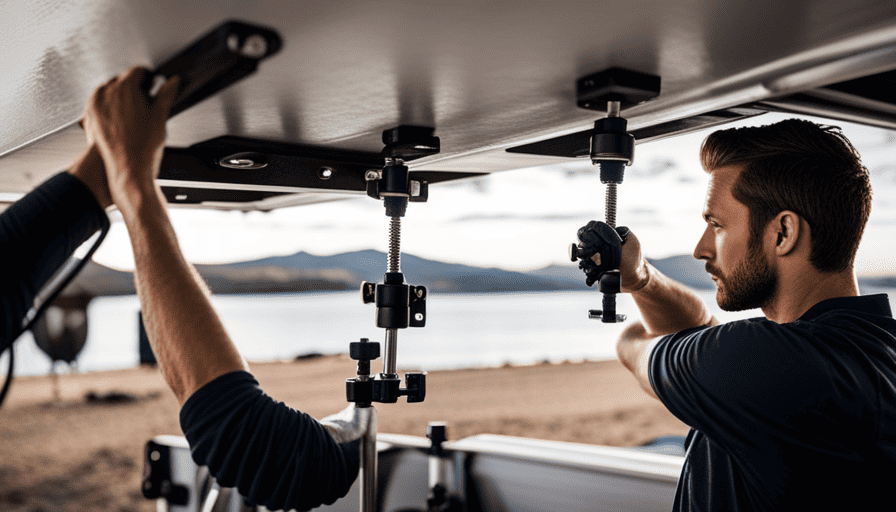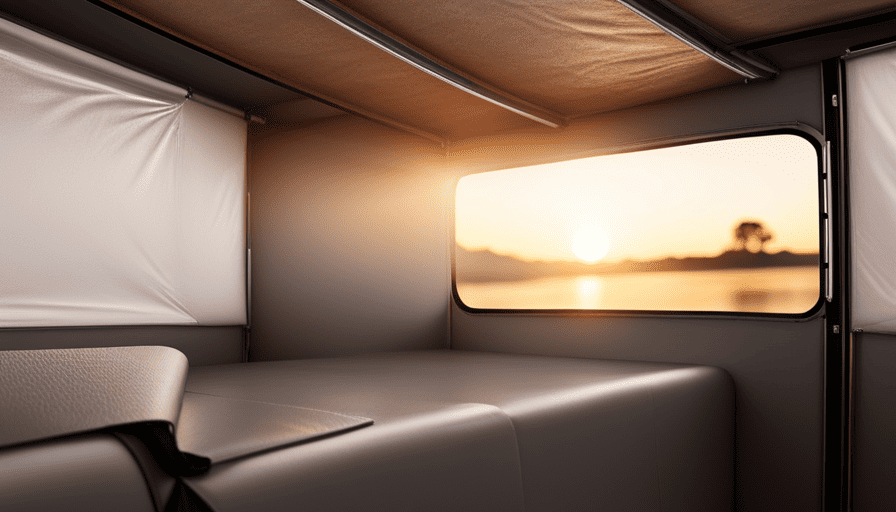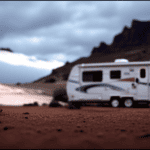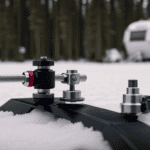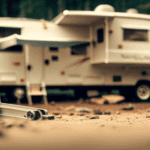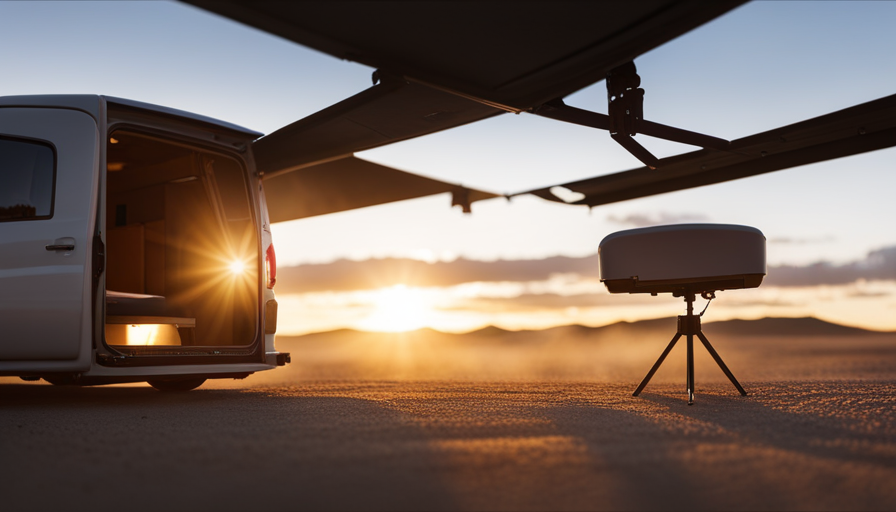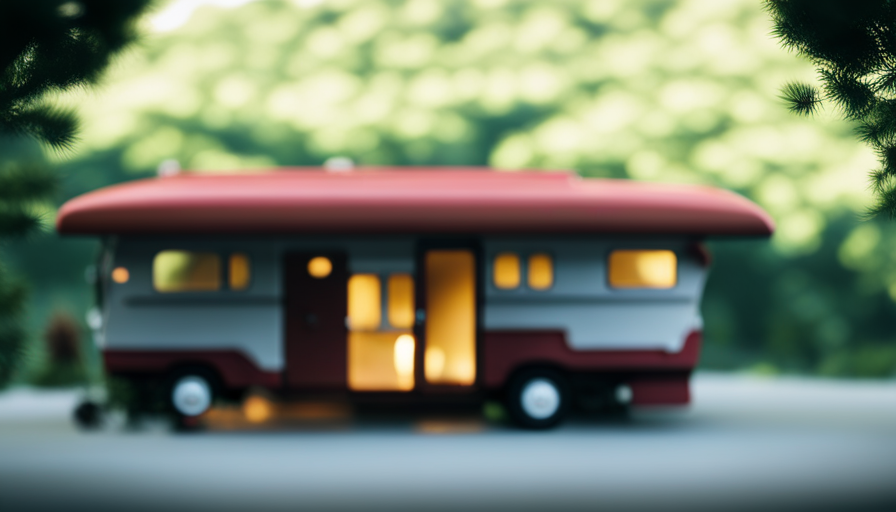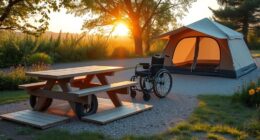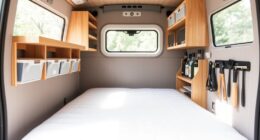During my most recent camping trip, I became aware of the considerable swaying and rocking of my camper every time the wind blew or a vehicle passed by. This realization made me realize the importance of finding a solution to ensure a smoother and safer travel experience. That’s when I discovered the essential role of installing sway bars on my camper.
Sway bars, also known as stabilizer bars, are a crucial addition to any camper as they help minimize sway and improve overall stability. By connecting the camper’s frame to the suspension, sway bars effectively distribute weight and reduce the risk of accidents caused by excessive movement.
In this article, I will guide you through the process of installing sway bars on your camper. From assessing your camper’s needs and gathering the necessary tools to attaching the sway bar and fine-tuning its performance, I will provide you with step-by-step instructions to ensure a successful installation.
So let’s get started and make your camper experience smoother and safer than ever before.
Key Takeaways
- Assessing the weight, size, and type of camper is crucial for choosing the right size and setup of sway bars.
- Park the camper on a level surface before starting the installation process.
- Position the sway bar brackets on the camper frame and securely fasten them to prevent movement or shifting.
- Adjust the sway bar tension using the tension adjustment bolts on the sway bar brackets.
Assess Your Camper’s Needs
You’ll want to assess your camper’s needs before diving into installing sway bars. This is an important step to ensure that you choose the right sway bar size and setup for your specific camper.
Start by assessing the weight of your camper. Knowing the weight will help you determine the appropriate sway bar size to effectively distribute the weight and reduce sway while towing. You can find the weight information in the owner’s manual or by visiting a certified weigh station.
Once you have the weight information, consider the size and type of your camper. Factors such as length, height, and weight distribution can all affect the sway of your camper. A larger or heavier camper may require a more robust sway bar setup to provide adequate stabilization. On the other hand, a smaller camper may only need a lighter sway bar setup.
By assessing your camper’s weight and size, you can determine the appropriate sway bar size and setup that will best suit your camper’s needs. With this information in hand, you can now move on to gathering the necessary tools and materials for the installation process.
Gather the Necessary Tools and Materials
To properly equip your vehicle, grab the essential tools and materials needed for this task. Here are the three items you’ll need:
-
Sway bar kit: Make sure you choose the right size sway bar for your camper. Assess your camper’s stability by considering its weight, size, and the type of terrain you plan to navigate. A larger and heavier camper will require a heavier-duty sway bar to effectively reduce sway.
-
Wrench set: You’ll need a set of wrenches in various sizes to tighten and secure the sway bar components. Make sure to have both metric and standard sizes to cover all the bolts and nuts involved.
-
Jack stands: These will be handy when raising and stabilizing your camper during the installation process. Opt for durable and sturdy jack stands that can safely support the weight of your camper.
Assessing your camper’s stability and choosing the right size sway bar are essential steps in ensuring a successful installation.
Once you’ve gathered these tools and materials, you can proceed to the next section about preparing your camper for the installation process.
Prepare Your Camper
Before installing sway bars on my camper, I made sure to park it on a level surface to ensure stability during the process.
Next, I disconnected any electrical or plumbing connections to prevent any damage or interference. This step was crucial in ensuring a smooth and efficient installation of the sway bars.
Park your camper on a level surface
Once you’ve found a nice level spot in the campground for your camper, it’s time to dive into installing those sway bars! Before you start, make sure to park your camper on a level surface. This is crucial for the proper installation of the sway bars.
To achieve a level surface, you can use leveling blocks or leveling jacks. Place the blocks or extend the jacks under the camper’s tires to adjust the height and ensure that it is perfectly level.
Once your camper is level, you can proceed with the installation of the sway bars. But before we get into that, it’s important to disconnect any electrical or plumbing connections to ensure a smooth and hassle-free installation process.
Disconnect any electrical or plumbing connections
Make sure you unplug any electrical or plumbing connections in order to ensure a seamless and hassle-free installation process for your camper.
Start by disconnecting any electrical connections, such as the power cord or any connected devices. This’ll prevent any damage to the electrical system during the installation.
Next, disconnect any plumbing connections, such as the water hose or sewage lines. This’ll ensure that no water or waste leaks out during the installation.
It’s important to take your time and carefully disconnect each connection, making sure to secure any loose ends.
Once everything’s safely disconnected, you can move on to the next step of installing the sway bar brackets. This’ll ensure that your camper remains stable and secure while on the road.
Install the Sway Bar Brackets
First, I position the sway bar brackets on the camper frame, ensuring they’re aligned correctly for optimal performance.
Using the provided hardware, I securely fasten the brackets, making sure they’re tightly attached to the frame to prevent any movement or shifting.
This step is crucial in ensuring the stability and effectiveness of the sway bars when towing the camper.
Position the brackets on the camper frame
To properly position the brackets on your camper frame, align them with the designated mounting points and make sure they’re securely attached.
- Start by identifying the correct placement for the brackets on the frame. Refer to the manufacturer’s instructions or the camper’s manual for specific guidelines.
- Use a measuring tape to ensure accurate alignment of the brackets with the mounting points. This step is crucial to ensure proper functioning of the sway bars.
Once the brackets are aligned, use a wrench or socket set to tighten the bolts securely. Make sure the brackets are firmly attached to the frame to prevent any movement during travel.
With the brackets in position, the next step is to secure them using the provided hardware. This will ensure that the sway bars are properly installed and ready for use.
Secure the brackets using the provided hardware
After positioning the brackets on the camper frame, the next step in installing sway bars is to secure the brackets using the provided hardware. This is a crucial step to ensure the stability and effectiveness of the sway bars.
Begin by aligning the holes on the brackets with the corresponding holes on the frame. Then, insert the bolts through the holes and tighten them using a wrench or socket set. Make sure to check the manufacturer’s instructions for the recommended torque specifications.
It’s important to ensure that the brackets are securely attached to the frame to prevent any movement or shifting during travel.
Once the brackets are securely fastened, you can proceed to the next step of attaching the sway bar to the brackets, ensuring a reliable and safe installation.
Attach the Sway Bar to the Brackets
Now, you’re ready to securely attach the sway bar to the brackets, ensuring a smooth and worry-free journey that’ll leave you feeling confident and in control.
Installing sway bars on your camper provides numerous benefits, such as improved stability and reduced sway while towing.
To begin, make sure the sway bar is properly aligned with the brackets and insert the provided bolts through the holes, ensuring a snug fit. Tighten the bolts using a wrench or socket until they’re securely fastened.
It’s important to double-check that the sway bar is aligned properly and centered between the brackets to ensure optimal performance.
Once attached, give the sway bar a gentle tug to confirm it’s securely in place.
Now that the sway bar is securely attached, you can move on to the next step of adjusting the sway bar tension. This’ll allow you to fine-tune the performance of the sway bar to suit your specific towing needs.
Adjust the Sway Bar Tension
Once you’ve securely attached the sway bar, you can fine-tune the tension to optimize its performance and tailor it to your specific towing needs. Adjusting the sway bar tension is crucial to ensure stability and minimize sway while towing your camper.
Here’s how you can do it:
-
Start by locating the tension adjustment bolts on the sway bar brackets. These bolts are typically located on the ends of the sway bar and can be tightened or loosened to adjust the tension.
-
Use a wrench or socket set to turn the adjustment bolts clockwise to increase tension or counterclockwise to decrease tension. It’s important to make small adjustments and test the sway bar’s performance after each adjustment to find the optimal tension.
Troubleshooting sway bar issues:
-
If your camper still experiences excessive sway after increasing tension, check if the sway bar is properly attached and the brackets are securely fastened.
-
Inspect the sway bar for any signs of damage or wear. Replace any worn-out components to ensure proper functioning.
Adjusting sway bar tension for different towing conditions:
-
For lighter loads or smoother roads, you may want to decrease the tension slightly to allow for more flexibility and a smoother ride.
-
When towing heavier loads or traveling on rough terrain, increasing the tension will provide more stability and control.
Remember, finding the right tension for your sway bar may require some trial and error. Once you’ve adjusted the tension, you can move on to testing and fine-tuning the sway bar’s performance.
Test and Fine-Tune the Sway Bar’s Performance
Fine-tuning the tension of your sway bar is the key to achieving optimal stability and control while towing, ensuring a smoother and safer ride. To test and fine-tune the sway bar’s performance, it is important to understand common issues that may arise and troubleshoot accordingly.
One effective way to evaluate the sway bar’s performance is by conducting a controlled test drive. Start by driving on a straight road and pay attention to any swaying or excessive body roll. Then, make a turn at a moderate speed and observe the vehicle’s response. If there is excessive sway or body roll during the turn, it indicates that the sway bar may need adjustment.
To fine-tune the sway bar’s tension, refer to the manufacturer’s guidelines or consult a professional. They will provide recommendations based on your camper’s specifications and weight distribution. Adjusting the sway bar tension involves tightening or loosening the sway bar links or adjusting the sway bar angle.
To help you understand the impact of sway bar adjustments, refer to the table below:
| Sway Bar Adjustment | Effect |
|---|---|
| Tightening | Increases stability and reduces body roll |
| Loosening | Enhances flexibility and allows for more independent wheel movement |
By testing and fine-tuning the sway bar’s performance, you can ensure a safer and more controlled towing experience. In the next section, we will discuss how to maintain your sway bars and prolong their lifespan.
Maintain Your Sway Bars
When it comes to maintaining sway bars, it’s crucial to regularly inspect them for any signs of wear or damage. This will help ensure their optimal performance and prevent any potential issues on the road.
Additionally, it’s important to follow the manufacturer’s recommendations and lubricate the sway bar bushings as needed. This will contribute to the overall longevity and smooth operation of the sway bars.
Regularly inspect the sway bars for signs of wear or damage
Make sure to regularly check your sway bars for any signs of wear or damage, as this is crucial for maintaining the stability and safety of your camper. Inspecting the sway bar condition is a simple yet essential task that should be done on a regular basis. Look for any visible signs of wear, such as cracks, rust, or bent components. Pay close attention to the bushings, as they can wear out over time and affect the performance of the sway bars. To help you keep track of your inspections, use the following table:
| Sway Bar Component | Signs of Wear or Damage |
|---|---|
| Sway bar itself | Cracks, rust, bending |
| Bushings | Wear, tears |
| Mounting brackets | Loose bolts, cracks |
By regularly inspecting your sway bars, you can identify any issues early on and address them promptly. This will help ensure that your camper remains stable and safe on the road. After inspecting the sway bars, it is important to lubricate the sway bar bushings as recommended by the manufacturer in order to maintain their optimal performance.
Lubricate the sway bar bushings as recommended by the manufacturer
After inspecting the sway bars for any signs of wear or damage, it’s crucial to properly lubricate the sway bar bushings. This ensures smooth movement and reduces friction, enhancing the overall performance of the sway bars. Following the manufacturer’s recommendations for lubrication is essential to maintain the effectiveness of the sway bars.
Here are some important lubrication tips to keep in mind:
- Use a high-quality lubricant specifically designed for sway bar bushings.nn2. Apply the lubricant evenly to all contact surfaces of the bushings.nn3. Avoid over-lubricating, as excessive lubrication can attract dirt and debris.nn4. Regularly check the bushings for any signs of dryness or excessive wear and reapply lubricant as needed.
Proper lubrication is often overlooked, but it plays a vital role in optimizing the performance of sway bars. Neglecting this step can lead to premature wear and reduced effectiveness.
Now, let’s consider additional stabilization options for your camper.
Consider Additional Stabilization Options
One option to enhance stability while on the road is to explore additional ways to keep your camper steady. In addition to installing sway bars, there are other additional stabilization methods that can provide further benefits. These methods can help minimize swaying and improve overall control of your camper, resulting in a smoother and safer experience.
One effective method is using weight distribution hitches. These hitches redistribute the weight of the camper, ensuring that it is evenly distributed between the tow vehicle and the trailer. This helps to reduce the amount of weight placed on the rear of the tow vehicle and can significantly improve stability.
Another method is utilizing stabilizer jacks. These jacks are placed underneath the camper to provide extra support and prevent excessive movement. They can be easily adjusted to ensure that the camper remains level and steady, even on uneven terrain.
Lastly, consider investing in leveling blocks. These blocks can be placed under the tires of your camper to help level it and prevent it from rocking back and forth. This can greatly reduce swaying and provide a more comfortable ride.
By incorporating these additional stabilization methods, you can enjoy a smoother and safer camper experience.
Enjoy a Smoother and Safer Camper Experience
After considering additional stabilization options for your camper, it’s time to delve into the current subtopic: enjoying a smoother and safer camper experience by installing sway bars. This upgrade is essential for improving camper suspension and provides numerous benefits that will enhance your overall camping trip.
-
Stability: Sway bars effectively reduce the side-to-side motion of your camper, ensuring a more stable ride. This is particularly important when navigating winding roads or encountering strong crosswinds.
-
Control: By minimizing sway, sway bars give you greater control over your camper, allowing for easier steering and maneuvering. This is especially beneficial when navigating tight turns or changing lanes on the highway.
-
Safety: The improved stability and control provided by sway bars ultimately translate into a safer camper experience. With reduced sway, the risk of trailer sway-induced accidents is significantly decreased, providing peace of mind for you and your fellow travelers.
Installing sway bars on your camper is a worthwhile investment that will greatly enhance your camping experience. Not only will it improve your camper’s suspension, but it will also provide you with the stability, control, and safety you need for a smooth and enjoyable journey.
Frequently Asked Questions
How do I determine if my camper needs sway bars?
To determine if your camper needs sway bars, you should consider factors such as its weight, size, and towing capacity. Assess the stability of your camper while towing to identify any excessive swaying or instability. If you notice significant swaying, it’s recommended to install sway bars.
When choosing the right size sway bars, refer to your camper’s specifications and consult with a professional if needed. Properly adjust the sway bars for optimal performance to enhance stability and control during towing.
Can I use regular tools to install sway bars on my camper?
Oh, absolutely! You can definitely use regular tools to install sway bars on your camper. After all, who needs those specialized tools designed specifically for this task? They’re just for show, right?
But wait, let me enlighten you about the advantages of using specialized tools. They ensure precise and accurate installation, preventing common mistakes like improper torquing or misalignment. So, while regular tools might get the job done, specialized tools are the key to a flawless installation.
Are sway bars compatible with all types of campers?
Sway bars are generally compatible with most types of campers, regardless of size. However, their effectiveness may vary depending on the size and weight distribution of the camper.
For smaller campers, sway bars can greatly improve stability and reduce swaying during travel. However, for larger campers, sway bars may not be as effective due to their increased weight and size.
It is important to consider the pros and cons of using sway bars for camper stability before making a decision.
How often do I need to maintain the sway bars on my camper?
To properly maintain sway bars on my camper, it’s important to regularly inspect them for any signs of wear and tear. Look out for cracks, rust, or loose connections. Clean the bars with a mild detergent and water, and lubricate the moving parts with silicone spray.
Additionally, make sure that the bolts are tightened to the manufacturer’s specifications. By following these steps, you can ensure the longevity and effectiveness of your sway bars.
What other stabilization options should I consider for my camper?
When considering stabilization methods for off-road campers, there are several options to consider.
One popular choice is weight distribution hitches, which help distribute the weight evenly between the camper and the towing vehicle. This can improve stability and control, particularly when towing on uneven terrain. Weight distribution hitches also help reduce sway and improve braking performance. They’re relatively easy to install and can greatly enhance the overall towing experience.
Are Sway Bars Necessary for Installing on a Camper?
When it comes to towing a camper, it’s important to consider if you need to hook up sway bars. Sway bars can help improve stability and control while towing, especially in windy or uneven terrain. They are not absolutely necessary, but they can make the towing experience smoother and safer.
Conclusion
In conclusion, installing sway bars on your camper can greatly enhance your safety and overall camping experience. By carefully assessing your camper’s needs and following the precise installation process, you can ensure that your camper remains stable and secure on the road.
Regular maintenance and considering additional stabilization options can further improve the performance of your sway bars. So, take the necessary steps to enjoy a smoother and safer journey, and let your worries sway away with the wind.

